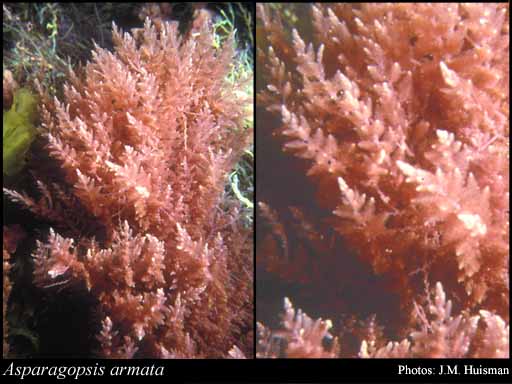- Reference
- Trans.Roy.Irish Acad. 544 (1855)
- Conservation Code
- Not threatened
- Naturalised Status
- Native to Western Australia
- Name Status
- Current







Scientific Description
Habit and structure. Thallus (gametophyte) grey-brown to dark red, 8–25 cm high, with long, plumose, main branches covered with densely and irregularly radially branched laterals mostly 5–10 mm long, with crowded ramuli 1–2 mm long when mature and 50–110 µm in basal diameter, tapering gradually; scattered (sometimes clustered), bare, but retrorsely spinous branches 1–3 cm long, with spirally arranged (divergence one quarter)spines 0.25–1 mm long, also occur. Attachment by the spinous branches, which can develop adhesive pads; epiphytic on various algae and seagrasses. Structure uniaxial, each subapical cell with two opposite periaxial cells diverging on about a one quarterspiral, with the larger forming an indeterminate branch or a determinate ramulus, the smaller opposite one often forming a determinate ramulus. Cortex formed from cells cut off laterally from the periaxial cells, becoming continuous within a few axial cells of the apices and on older branches several cells thick, with a space between the axial filament and inner cortical cells within which sparse (in young branches) to denser rhizoidal filaments develop; inner cortical cells ovoid to angular, 35–60 µm in diameter, outer cortical cells angular in surface view, 10–25 µm across; axial filament becoming 40–150 µm in diameter, with swollen ends. Ramuli developing 5 periaxial cells around each axial cell (three in sectional view), one full length and two pairs of half length, almost cubical, cells each 25–35 µm across; many cells with small gland cells on their inner sides. Rhodoplasts discoid, numerous, in chains in inner cortical cells. Tetrasporophytes densely tufted, 0.5–2 cm high, much branched with filaments 40–60 µm in diameter, segments 45–85 µm long (L/D 1–1.5), with 3 pericentral cells around each axial cell, most pericentral cells cutting off inwardly a small gland cell. Attachment by short multicellular haptera; epilithic or epiphytic.
Reproduction. Gametangial thalli dioecious. Carpogonial branches 3-celled, borne on a supporting cell 9–11 axial cells along a lateral branchlet, with the lower cells of the carpogonial branch producing lateral nutritive cells. Carposporophyte with a basal, dendroid, fusion cell and a densely branched tuft of gonimoblast filaments bearing terminal, clavate to elongate-ovoid, carposporangia 15–25 µm in diameter. Cystocarps often paired near the base of lateral branches, globular, stalked by the lateral branchlet, 1–1.5 mm in diameter, pericarp 3–4 cells thick, ostiolate. Spermatangial heads short stalked, elongate-ovoid, 90–150 µm in diameter and 250–450 µm long, with a cortex of large inner cells and small outer cells producing several elongate spermatangia 1–2 µm in diameter. Tetrasporangia transformed from pericentral cells, forming an irregular series, shortly ovoid and 25–5 µm in diameter, cruciately divided.
Distribution. Yanchep, W. Aust., around southern Australia and Tas., to Port Stephens, N.S.W. Northern Australia?. Western Europe (Mediterranean to Ireland); Chile; New Zealand.
[After Womersley, Mar. Benthic Fl. Southern Australia IIIB: 327–331 (1996)]
Distribution
- IBRA Regions
- Esperance Plains, Warren.
- IBRA Subregions
- Recherche, Warren.
- IMCRA Regions
- Abrolhos Islands, Central West Coast, Leeuwin-Naturaliste, WA South Coast.
- Local Government Areas (LGAs)
- Augusta Margaret River, Esperance, Greater Geraldton, Rockingham.